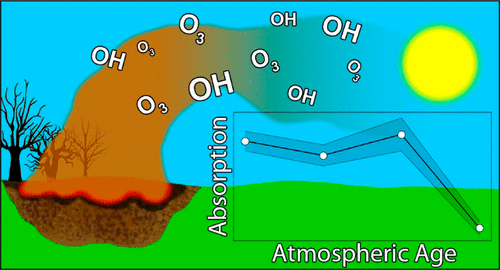当前位置:
X-MOL 学术
›
Environ. Sci. Technol. Lett.
›
论文详情
Our official English website, www.x-mol.net, welcomes your
feedback! (Note: you will need to create a separate account there.)
Atmospheric Photooxidation Diminishes Light Absorption by Primary Brown Carbon Aerosol from Biomass Burning
Environmental Science & Technology Letters ( IF 8.9 ) Pub Date : 2017-09-25 00:00:00 , DOI: 10.1021/acs.estlett.7b00393 Benjamin J. Sumlin 1 , Apoorva Pandey 1 , Michael J. Walker 1 , Robert S. Pattison 2 , Brent J. Williams 1 , Rajan K. Chakrabarty 1, 3
Environmental Science & Technology Letters ( IF 8.9 ) Pub Date : 2017-09-25 00:00:00 , DOI: 10.1021/acs.estlett.7b00393 Benjamin J. Sumlin 1 , Apoorva Pandey 1 , Michael J. Walker 1 , Robert S. Pattison 2 , Brent J. Williams 1 , Rajan K. Chakrabarty 1, 3
Affiliation

|
Light-absorbing organic aerosols, optically defined as brown carbon (BrC), have been shown to strongly absorb short visible solar wavelengths and significantly impact Earth’s radiative energy balance. There currently exists a knowledge gap regarding the potential impacts of atmospheric processing on the absorptivity of such particles generated from biomass burning. Climate models and satellite retrieval algorithms parametrize the optical properties of BrC aerosols emitted from biomass burning events as unchanging throughout their atmospheric lifecycle. Here, using contact-free optical probing techniques, we investigate the effects of multiple-day photochemical oxidation on the spectral (375–532 nm) optical properties of primary BrC aerosols emitted from smoldering combustion of boreal peatlands. We find the largest effects of oxidation in the near-UV wavelengths, with the 375 nm imaginary refractive index and absorption coefficients of BrC particles decreasing by ∼36% and 46%, respectively, and an increase in their single scattering albedo from 0.85 to 0.90. Based on simultaneous chemical characterization of particles, we infer a transition from functionalization to fragmentation reactions with increasing photooxidation. Simple radiative forcing efficiency calculations show the effects of aging on atmospheric warming attributed to BrC aerosols, which could be significant over snow and other reflective surfaces.
中文翻译:

大气光氧化减少了生物质燃烧产生的初级棕碳气溶胶的光吸收
吸光性有机气溶胶,光学上定义为棕碳(BrC),已被证明可以强烈吸收短的可见太阳波长,并显着影响地球的辐射能平衡。当前,关于大气处理对由生物质燃烧产生的此类颗粒的吸收性的潜在影响存在知识差距。气候模型和卫星检索算法将生物量燃烧事件排放的BrC气溶胶的光学特性参数化,使其在整个大气生命周期中均保持不变。在这里,使用非接触式光学探测技术,我们研究了多日光化学氧化对北方泥炭地的阴燃燃烧所散发的初级BrC气溶胶的光谱(375–532 nm)光学性质的影响。我们发现在近紫外波长下氧化作用最大,BrC颗粒的375 nm虚构折射率和吸收系数分别降低了约36%和46%,其单散射反照率从0.85增加到0.90 。基于粒子的同时化学表征,我们推断随着光氧化作用的增加,从官能化过渡到片段化反应。简单的辐射强迫效率计算显示了老化对归因于BrC气溶胶的大气变暖的影响,这在积雪和其他反射表面上可能非常明显。基于粒子的同时化学表征,我们推断随着光氧化作用的增加,从官能化过渡到片段化反应。简单的辐射强迫效率计算显示了老化对归因于BrC气溶胶的大气变暖的影响,这在积雪和其他反射性表面上可能非常明显。基于粒子的同时化学表征,我们推断随着光氧化作用的增加,从官能化过渡到片段化反应。简单的辐射强迫效率计算显示了老化对归因于BrC气溶胶的大气变暖的影响,这在积雪和其他反射表面上可能非常明显。
更新日期:2017-09-25
中文翻译:

大气光氧化减少了生物质燃烧产生的初级棕碳气溶胶的光吸收
吸光性有机气溶胶,光学上定义为棕碳(BrC),已被证明可以强烈吸收短的可见太阳波长,并显着影响地球的辐射能平衡。当前,关于大气处理对由生物质燃烧产生的此类颗粒的吸收性的潜在影响存在知识差距。气候模型和卫星检索算法将生物量燃烧事件排放的BrC气溶胶的光学特性参数化,使其在整个大气生命周期中均保持不变。在这里,使用非接触式光学探测技术,我们研究了多日光化学氧化对北方泥炭地的阴燃燃烧所散发的初级BrC气溶胶的光谱(375–532 nm)光学性质的影响。我们发现在近紫外波长下氧化作用最大,BrC颗粒的375 nm虚构折射率和吸收系数分别降低了约36%和46%,其单散射反照率从0.85增加到0.90 。基于粒子的同时化学表征,我们推断随着光氧化作用的增加,从官能化过渡到片段化反应。简单的辐射强迫效率计算显示了老化对归因于BrC气溶胶的大气变暖的影响,这在积雪和其他反射表面上可能非常明显。基于粒子的同时化学表征,我们推断随着光氧化作用的增加,从官能化过渡到片段化反应。简单的辐射强迫效率计算显示了老化对归因于BrC气溶胶的大气变暖的影响,这在积雪和其他反射性表面上可能非常明显。基于粒子的同时化学表征,我们推断随着光氧化作用的增加,从官能化过渡到片段化反应。简单的辐射强迫效率计算显示了老化对归因于BrC气溶胶的大气变暖的影响,这在积雪和其他反射表面上可能非常明显。











































 京公网安备 11010802027423号
京公网安备 11010802027423号